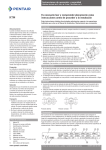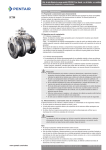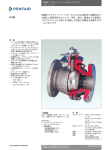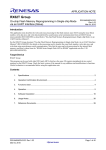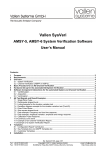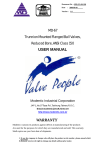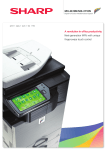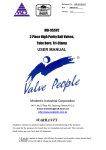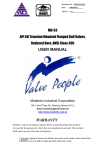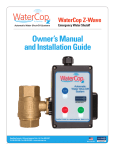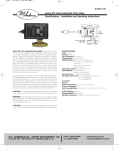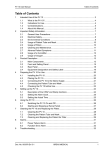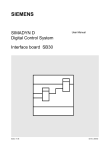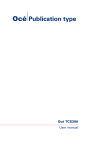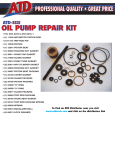Download KTM Ball Valves, Model OM-2 Split Body
Transcript
KTM OM-2 Split Body Floating Ball Valves (Soft seat - Gratite seat - Metal seat) Installation and Maintenance Instructions KTM Section 1 - Storage 1.1. Preparation and preservation for storage All valves should be properly packed in order to protect the parts that are subject to deterioration during transportation and storage on site. In particular, the following precautions should be taken: • The valves must be packed with the ball in the open position. • The flange sealing surface (raised face) shall be protected with suitable protective oil. • The end faces of the valve must be protected with appropriate seal discs. • The type of packing must be defined in the Customer’s Order and be appropriate to ensure safe transportation to the final destination and eventual storage before installation. Wrapping and/or covers should be left in place until just prior to installation. 1.2. Handling requirements 1.2.1. Packed valves Crates:Appropriate crate handling equipment should be used to prevent damage to crated valves. Boxes:Handling of valves packed in carton boxes should be done with extra caution, taking specific note to lifting points and the center of gravity. The transportation of all packed valves and components must be carried out safely and in accordance with all local safety regulations. Pay particular attention to the lifting limits of handling equipment with reference to the overall weight of packed and unpacked valves. 1.2.2. Unpacked valves • The handling of valves unpacked from its original packing needs to be carried out with additional exterior protection in order to avoid damages to machined surfaces. Use pallets at all times, where appropriate. • When handling large valves, appropriate tools (brackets, hooks, fasteners, ropes) should be used to secure valves firmly; and lifting loads should be balanced in order to prevent the valves from falling or moving during the handling process. Caution • When handling valves, the correct equipment and accessories (slings, fasteners, hooks, etc.) must be sized and selected, taking into consideration the individual and/or overall valves weight indicated in the packing list and/or delivery note. • Lifting and handling must be made only by qualified personnel. Improper hoisting can cause valve deformation or damage from dropping the valve. • Do not lift valves by using lifting points or lugs located on the actuator as these lifting points/lugs are for the actuator only. • Do not lift the valve by its hand-lever as these levers are not designed to take the load of the whole valve. Doing so may cause the lever to break off or be disconnected from the valve, resulting in possible valve damage or injury. • Avoid lifting over a worker’s head or equipment, or any other thing that can possibly be damaged or cause of injury in the event that the lifted load falls off the handling equipment. • All local safety regulations must be observed and complied with at all times. 1.3. Storage and preservation before installation The storage of the valves should be in accordance with the following criteria: • Storage room should be clean and dry. • The ball must be in the open position and the end faces must be protected with appropriate seal discs. • Periodical checks have to be carried out in the storage area to verify that the above mentioned conditions are maintained. Caution The ball valves are delivered with the ball in the full-open position and should be stored as they are. Keeping the ball in other positions or half-open position for an extended period of time could cause seat leakage. Note • Do not place consignment package directly on the ground. • Do not expose consignment packages to the rain/wind or directly to the sun. • Storage in an open area for a limited period can be considered only if the valves have appropriate packing (packed in cases covered with vinyl sheets protecting from rain, wind, dust etc, and contents well protected with barrier sacks). • Store in a dry and well ventilated condition. • If storage is anticipated for an extended period, the desiccant bags (if supplied) should be changed every 6 months. www.pentair.com/valves Pentair reserves the right to change the contents without notice KTMWY-0002-EN-1306 KTM OM-2 Split Body Floating Ball Valves (Soft seat - Gratite seat - Metal seat) Installation and Maintenance Instructions Section 2 - Installation 2.1. Preparation before installation • Remove the valve from the shipping package (box or pallet) with care taken to avoid any damage to the valve and actuator (plus accessories where applicable). • Before installation, remove the seal discs from the flange. Clean the inside of the valve using an air line that includes an appropriate air-filter. Ensure that there are no solid objects such as pieces of wood, plastic or packing materials within the valve or on the valve seat. • Confirm that the materials of construction listed on the valve nameplates are appropriate for the service intended for and are as specified. When in doubt contact KTM, or your local Pentair facility. • Define the preferred mounting orientation with respect to the system pressure. The arrow on the body helps to identify the upstream side (high pressure) and downstream side (low pressure). • Ensure that all stud bolts and nuts of the body joint are firmly fastened. Caution • Verify that the direction of the flow in the line corresponds to the arrow indicated on the valve body. Valves without the arrow are bi-directional. • See the Actuator User Manual for the actuator preparation. 2.2. Installation Instructions • Ball valves are normally installed in horizontal pipes with the stem facing up. However, there are no limitations regarding the pipe or stem orientation. • Unless otherwise recommended by KTM, the valve should be installed with the ball in the open position, to ensure that the seat rings are not damaged during installation. • Particular care should be taken for valves equipped with “fail-close” actuators. • For operating temperatures above 200°C (392°F), thermal insulation of the valve body is recommended to protect the actuator/accessories from heat beyond the recommended temperature range. • Handling and lifting of the valves during installation MUST be performed following the same criteria and instructions described in points 1.2. and 1.3. Important • It is recommended to perform pipe flushing before installation of the valve. If this is not possible, the installed valve must be in its open position before flushing takes place. • When conducting pressure test of the pipe system, the valve should be in a full or half open position. Check for any leakage from the joint flange and gland portion during the pressure test. • If the piping system is pressurized with water for testing, and if the piping system has been shut down for a long time after testing, the following recommendation should be adopted: 1. Use corrosion inhibitor with water to pressurize the piping system. 2. After testing, the piping system should be depressurized and the test water completely drained. 3. Ensure that the corrosion inhibitor does not leave a residue within the system as the particulates may damage the valve sealing surfaces. Caution During the pipe system pressure test, care must be taken not to set the valve in the closed position to avoid overload pressure which may cause seat deformation or seat leakage. 2.3. Valve verification before start-up • Tighten the gland nut just enough to prevent stem leakage. Over-tightening will decrease packing life and increase operating torque. There is no need to over-tighten the stud bolts/nuts to assure gasket tightness. • Check the operation of the valve by stroking it to “full open” and “full close”. The valve ball travels clockwise to close. Pentair reserves the right to change the contents without notice page 2 KTM OM-2 Split Body Floating Ball Valves (Soft seat - Gratite seat - Metal seat) Installation and Maintenance Instructions Section 3 - Operation instructions Either the hand lever or the direction of the parallel flats on the top of the stem indicate the open or closed position of the KTM ball valve. For gear operated valves, the position is indicated by the arrow-indicator (see picture). Open position Excessive over travel during handle operation may break the lever, injure the operator, and/or deform the stopper or the stem, which may lead to seat leakage. The following instructions will help provide a satisfactory and long life service. 1. Perform periodic valve verification. 2.In the case of actuated valves, always follow the specific instructions given by the actuator’s manufacturer. 3.Never change the setting of torque and/or limit switches set during the final test by the manufacturer. 4.Never change the setting of the mechanical stops of the gearbox. Closed position Adjustment Screws Locking device (option) A locking device can be provided to prevent unauthorized operation. Lock pin dimensions (options) Indicator Valve nominal diameter Unit: mm Pin dimensions Nominal pad lock (full bore) L d diameter alpha number 15 - 25 40 - 50 65 - 100 150 - 200 25 31 39 - 4,9 6,5 8 - 1,000 - 25 m/m 1,000 - 25 m/m 1,000 - 25 m/m 1,000 - 25 m/m Lock Section 4 - Maintenance No routine maintenance is required other than periodic inspection to ensure satisfactory operation. 4.1. Gland packing maintenance If leakage is observed through the gland packing, tighten the gland nuts slowly and evenly until the leakage stops. Do not over-tighten the packing gland nuts. Over-tightening will increase the torque required to operate the valve. Follow the torque table to ensure correct torque used when tightening the gland nut. Tightening torque for body joint and gland Body joint Gland Class 150 Packing material 300 RTFE or Soft carbon Valve size 150 and 300 PTFE Soft carbon 2 2 3 7 7 16 16 19 19 32 4 4 6 15 15 30 30 40 40 65 Standard tightening torque* (Nm) (mm) (inch) Bolt size 15 20 25 40 50 65 80 100 150 200 1/2” 3/4” 1” 1 1/2” 2” 2 1/2” 3” 4” 6” 8” M8 M8 M10 M8 M10 M12 M12 M14 M16 M20 13 - 18 13 - 18 27 - 35 13 - 18 27 - 35 49 - 54 49 - 54 75 - 86 118 - 131 220 - 270 Bolt size 18 - 23 18 - 23 36 - 46 36 - 46 61 - 77 93 - 123 93 - 123 148 - 187 385 - 488 492 - 625 M8 M8 M10 M10 M12 M14 M14 M16 M22 M24 * Standard for Soft (E) seat, Gratite seat and Metal seat Pentair reserves the right to change the contents without notice page 3 KTM OM-2 Split Body Floating Ball Valves (Soft seat - Gratite seat - Metal seat) Installation and Maintenance Instructions Replace the gland packing as and when necessary. • Remove the lever or gear operator, snap ring and stopper. • Remove the gland bolts and flange. • Replace the gland packing. Reverse the procedure. Gland bolt Gland flange Gland packing Gland bolt Stopper Stem Snap ring EB11 - 15 mm - 100 mm EB12 - 15 mm - 100 mm Stopper Gland bolt Gland bolt Stopper Gland flange Gland cover Gland packing Stem EB11 - 150 mm - 200 mm EB12 - 150 mm - 200 mm EB21 - 150 mm - 250 mm EB22 - 150 mm - 250 mm 4.2. Body seal maintenance Any sign of leakage through the body joint seal should be addressed immediately by tightening the stud nuts until the leakage stops. Follow the torque table to ensure the correct torque is used when tightening the gland nut. Gasket Caution Before removing the valve from the piping, ensure that the system has been fully depressurized and any dangerous fluids have been drained off. Failure to do so may cause serious personal injury and/or damage to the valve. 4.3. Valve disassembly Refer to the respective construction drawing(s) on the following page(s) of the valve(s) when disassembling. Numbers of parts vary slightly depending on the valve size, but the basic structures are identical. The valve shall be in the half open position. • Before disassembling the valve, ensure that it has been decontaminated from any harmful gasses or fluids and is within a safe temperature range for maintenance. • Rotate the ball to a closed position. • Loosen the hexagon nuts and remove the body cap from the body. The seat and gasket can then be easily removed. • Remove the ball and seat with care so as to prevent damage to the seal face of the ball. • Remove the snap ring of the stem with a pair of pincers and remove the gland bolts. Tap the stem head with a plastic hammer and withdraw it towards the interior of the body. Note The stem has been designed as “anti-blow out” to improve safety during system operation. This means that the stem cannot be removed from the valve body through the top of the body. It must be removed from within the valve body. Pentair reserves the right to change the contents without notice page 4 Bolt Nut KTM OM-2 Split Body Floating Ball Valves (Soft seat - Gratite seat - Metal seat) Installation and Maintenance Instructions Stem Stem bearing Thrust bearing 4.4. Valve re-assembly This work shall be carried out by reversing the aforementioned disassembling procedure. Further, the following points should be noted: • As shown in the diagram, slip a stem bearing over the stem; set in such a way so that it does not detach from the stem. Then insert it into the gland from the interior of the body. • Insert the gland packing (see 4.1.) and tighten the gland bolts lightly. • Since old gaskets occasionally adhere to the body and body cap when the valve is disassembled, the wastes of old gaskets should be completely scraped off and the sealing surfaces should be cleaned before fitting new gaskets. • When inserting the ball into the valve body, hold the stem in the “SHUT” position as in the case of disassembling and perform insertion in the reversed manner for disassembling. • Tighten the body cap with the ball in the “SHUT” position. Nuts which face each other are diagonally and uniformly tightened with equal strength, taking care to avoid one-sided tightening. • Exercise care in re-assembling the valve because its opening and closing vary depending upon whether the correct facing of the stopper (indicating OPEN and CLOSE) is well-set upwards. • Check the valve operation torque under no load in a dry form before pressure test. Ensure that the measured torque is within range of the standard torque table. In the event the torque is more than the standard torque for Metal and Gratite seated ball valves, reduce the torque by adding an extra gasket for the body joint. Valve torque after assembly Class 150 & 300 Seat Soft (E) Gland Packing PTFE Soft carbon Valve size Gratite PTFE or Soft carbon Metal PTFE or Soft carbon Standard valve torque* (Nm) (mm)(inch) 15 20 25 40 50 65 80 100 150 200 1/2” 3/4” 1” 1 1/2” 2” 2 1/2” 3” 4” 6” 8” 2 - 6 3 - 8 3 - 9 6 - 16 8 - 22 14 - 40 20 - 60 37 - 110 104 - 310 167 - 500 5 - 10 6 - 12 8 - 14 19 - 29 21 - 35 39 - 65 45 - 85 76 - 149 170 - 374 265 - 598 max 15 max 19 max 23 max 38 max 55 max 88 max 125 max 225 max 525 max 1000 max 7 max 7 max 11 max 20 max 25 max 35 max 40 max 55 max 100 max 150 * Torque measured after 2-3 times of operations under no load in a dry form before pressure test Pentair reserves the right to change the contents without notice page 5 KTM OM-2 Split Body Floating Ball Valves Installation and Maintenance Instructions Construction - Soft (E) seat ball valves (1/2” to 1”) Parts list No. Part name 1Body 2Cap 3Ball 4Stem 5Seat 6 Stem bearing 7 Stem bearing 8Stopper 9 Snap ring (C-type) 10 Thrust washer 11 Gland packing 12 Gland flange 13 Gland bolt 14 Stud bolt 15 Hexagon nut 16 Hexagon bolt 17Gasket 18Spring 19 Sp. washer 20 Pl. washer 21 Pk. washer 22Handle 23 Live loading spring Construction - Soft (E) seat ball valves (1-1/2” to 2-1/2”) 1 1 1 1 2 1 1 1 1 1 1 set 1 2 4 4 1 1 1 1 1 1 1 2 Parts list No. Part name 1Body 2Cap 3Ball 4Stem 5Seat 6 Stem bearing 7 Stem bearing 8 Thrust bearing 9Stopper 10 Snap ring (c-type) 11 Gland packing 12 Gland flange 14 Gland bolt 15 Stud bolt 16 Hexagon nut 17 Hexagon bolt 18Gasket 19Spring 21 Sp. washer 22 Pl. washer 23 Pk. washer 24Handle 28 Live loading spring Pentair reserves the right to change the contents without notice Qty. page 6 Qty. 1 1 1 1 2 1 1 1 1 1 1 set 1 2 6 6 1 1 1 1 1 1 1 2 KTM OM-2 Split Body Floating Ball Valves Installation and Maintenance Instructions Construction - Gratite seat ball valves Parts list No. Part name 1Body 2 Body cap 3Ball 4Stem 5Seat 6 Seat retainer 7 Inner ring 8Cushion 9 Stem bearing 10 Stem bearing 11 Thrust bearing 12 Gland packing 13 Pk. washer 14 Gland flange 15Gasket 16 Stud bolt 17 Hexagon nut 18 Gland bolt 19 Live loading spring 20Stopper 21 Sp. washer 22 Hexagon bolt 23Handle 24 Snap ring 25 Pl. washer Qty. 1 1 1 1 2 2 2 2 1 1 2 1 set 1 1 1 4-12 4-12 2 2 1 1 1 1 1 1 Part name 1Body 2 Body cap 3Ball 4Stem 5A Seat (A) 5B Seat (B) 6Gasket 7A Stem bearing (A) 7B Stem bearing (B) 8 Thrust bearing 9 Pk. washer 10 Gland packing 11 Gland flange 12 Live loading spring 13 Gland bolt 14 Stud bolt 15 Hexagon nut 16A Seat gasket (A) 16B Seat gasket (B) 17 Spring holder 18Spring 19Stopper 20 Hexagon bolt 21 Sp. washer 22Handle 23 Snap ring 24 Pl. washer Gland packing set Construction - Metal seat ball valves Parts list No. Adapter (2pcs) Qty. 1 1 1 1 1 1 1 1 1 2 1 1 set 1 2 2 4-12 4-12 1 1 1 1 1 1 1 1 1 1 Adapter (2pcs) Gland packing (3pcs) Gland packing set Note Before assembling, ball and seats shall be lapped with each other. Fine compound of approximately #1500 is recommended for the lapping. Pentair reserves the right to change the contents without notice page 7







